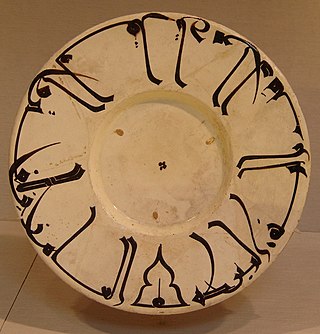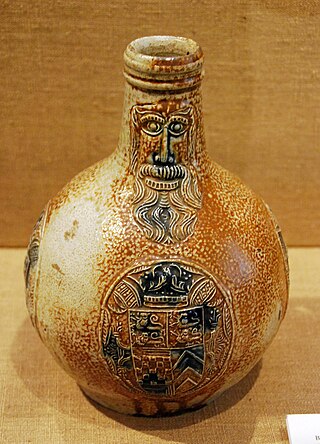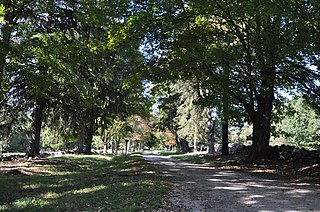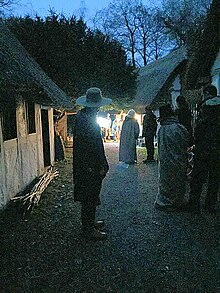
Pottery is the process and the products of forming vessels and other objects with clay and other raw materials, which are fired at high temperatures to give them a hard and durable form. The place where such wares are made by a potter is also called a pottery. The definition of pottery, used by the ASTM International, is "all fired ceramic wares that contain clay when formed, except technical, structural, and refractory products". End applications include tableware, decorative ware, sanitaryware, and in technology and industry such as electrical insulators and laboratory ware. In art history and archaeology, especially of ancient and prehistoric periods, pottery often means vessels only, and sculpted figurines of the same material are called terracottas.

Earthenware is glazed or unglazed nonvitreous pottery that has normally been fired below 1,200 °C (2,190 °F). Basic earthenware, often called terracotta, absorbs liquids such as water. However, earthenware can be made impervious to liquids by coating it with a ceramic glaze, and such a process is used for the great majority of modern domestic earthenware. The main other important types of pottery are porcelain, bone china, and stoneware, all fired at high enough temperatures to vitrify. End applications include tableware and decorative ware such as figurines.

Pottery and porcelain is one of the oldest Japanese crafts and art forms, dating back to the Neolithic period. Kilns have produced earthenware, pottery, stoneware, glazed pottery, glazed stoneware, porcelain, and blue-and-white ware. Japan has an exceptionally long and successful history of ceramic production. Earthenwares were made as early as the Jōmon period, giving Japan one of the oldest ceramic traditions in the world. Japan is further distinguished by the unusual esteem that ceramics hold within its artistic tradition, owing to the enduring popularity of the tea ceremony.

Celadon is a term for pottery denoting both wares glazed in the jade green celadon color, also known as greenware or "green ware", and a type of transparent glaze, often with small cracks, that was first used on greenware, but later used on other porcelains. Celadon originated in China, though the term is purely European, and notable kilns such as the Longquan kiln in Zhejiang province are renowned for their celadon glazes. Celadon production later spread to other parts of East Asia, such as Japan and Korea, as well as Southeast Asian countries, such as Thailand. Eventually, European potteries produced some pieces, but it was never a major element there. Finer pieces are in porcelain, but both the color and the glaze can be produced in stoneware and earthenware. Most of the earlier Longquan celadon is on the border of stoneware and porcelain, meeting the Chinese but not the European definitions of porcelain.

Salt-glaze or salt glaze pottery is pottery, usually stoneware, with a glaze of glossy, translucent and slightly orange-peel-like texture which was formed by throwing common salt into the kiln during the higher temperature part of the firing process. Sodium from the salt reacts with silica in the clay body to form a glassy coating of sodium silicate. The glaze may be colourless or may be coloured various shades of brown, blue, or purple.

Korean ceramic history begins with the oldest earthenware from around 8000 BC. Throughout the history, the Korean peninsula has been home to lively, innovative, and sophisticated art making. Long periods of stability have allowed for the establishment of spiritual traditions, and artisan technologies specific to the region. Korean ceramics in Neolithic period have a unique geometric patterns of sunshine, or it is decorated with twists. In Southern part of Korea, Mumun pottery were popular. Mumun togi used specific minerals to make colors of red and black. Korean pottery developed a distinct style of its own, with its own shapes, such as the moon jar or Buncheong sagi which is a new form between earthenware and porcelain, white clay inlay celadon of Goryeo, and later styles like minimalism that represents Korean Joseon philosophers' idea. Many talented Korean potters were captured and brought to Japan during the invasions of Korea, where they heavily contributed to advancing Japanese pottery. Arita ware, founded by Yi Sam-pyeong opened a new era of porcelain in Japan. Another Japanese representative porcelain, Satsuma ware was also founded by Dang-gil Shim and Pyeong-ui Park. 14th generation of Su-kwan Shim have been using the same name to his grandfather and father to honor they are originally Korean, 14th Su-kwan Shim is honorable citizen of Namwon, Korea.

The anagamakiln is an ancient type of pottery kiln brought to Japan from China via Korea in the 5th century. It is a version of the climbing dragon kiln of south China, whose further development was also copied, for example in breaking up the firing space into a series of chambers in the noborigama kiln.

Bizen ware is a type of Japanese pottery traditionally from Bizen province, presently a part of Okayama prefecture.

Chinese ceramics show a continuous development since pre-dynastic times and are one of the most significant forms of Chinese art and ceramics globally. The first pottery was made during the Palaeolithic era. Chinese ceramics range from construction materials such as bricks and tiles, to hand-built pottery vessels fired in bonfires or kilns, to the sophisticated Chinese porcelain wares made for the imperial court and for export. Porcelain was a Chinese invention and is so identified with China that it is still called "china" in everyday English usage.

Vietnamese ceramics refers to ceramic art and pottery as a form of Vietnamese art and industry. Vietnamese pottery and ceramics has a long history spanning back to thousands of years ago, including long before Chinese domination, as archeological evidence supports.

KatherineHarriot Duncombe Pleydell-Bouverie was a pioneer in modern English studio pottery, known for her wood-ash glazes.

The John Deere House and Shop is located in the unincorporated village of Grand Detour, Illinois, near the Lee County city of Dixon. The site is known as the location where the first steel plow was invented by John Deere in 1837. The site includes Deere's house, a replica of his original blacksmith shop, a gift shop, and an archaeological exhibit showing the excavation site of his original blacksmith shop. The Deere House and Shop is listed on the National Register of Historic Places; it joined that list in 1966, the year the Register was established. Prior to that, it was designated a National Historic Landmark on July 19, 1964.

Winchcombe Pottery, near Winchcombe in Tewkesbury Borough, North Gloucestershire, is an English craft pottery founded in 1926.

Goryeo ware refers to all types of Korean pottery and porcelain produced during the Goryeo dynasty, from 918 to 1392, but most often refers to celadon (greenware).

Ham Green Pottery was produced between 1100 AD to 1250 AD at a hamlet above the village of Pill called Ham Green in the English county of Somerset.

Ceramic art is art made from ceramic materials, including clay. It may take varied forms, including artistic pottery, including tableware, tiles, figurines and other sculpture. As one of the plastic arts, ceramic art is a visual art. While some ceramics are considered fine art, such as pottery or sculpture, most are considered to be decorative, industrial or applied art objects. Ceramic art can be created by one person or by a group, in a pottery or a ceramic factory with a group designing and manufacturing the artware.

Kyō ware is a type of Japanese pottery traditionally from Kyoto. It is therefore also known as Kyoto ware.

The Hervey Brooks Pottery Shop and Kiln Site is a historic industrial archaeological site in Goshen, Connecticut. It is the site of the 19th-century pottery of Hervey Brooks, a local potter significant for his extensive recordkeeping. Brooks' pottery included a shop and a stone kiln. The shop structure was moved to Old Sturbridge Village in the 20th century, where a reconstruction of his kiln has also been undertaken. The original site is of archaeological significance for identifying the materials Brooks used and how he laid out his work site, and for identifying how those changed over time.

Border ware is a type of post-medieval British pottery commonly used in the South of England, London and then later in the early American colonies beginning in the sixteenth and ending in the nineteenth century with a height of popularity and production in the seventeenth century. The lead-glazed, sandy earthenware was produced from kilns along the border between Hampshire and Surrey. There are two classes of Border ware, fine whitewares and fine redwares.
Gilbert Burroughes is a British potter, active since the 1950s. He became a specialist in reproducing samian ware.

























